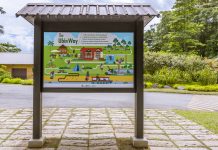Sustainable Tourism Singapore Series #2
United Nations had declared 2017 as the International Year Of Sustainable Tourism for Development. Here is the second post of my 4-post Sustainable Tourism Series on Singapore. You may read the first post HERE.
‘Pulau Ubin – Back to the Roots – Last Kampung of Singapore’ is the story of a commendable attempt by the Singapore Government to shield the flickering flames of local culture from the winds of modernisation.

Pulau Ubin – Back to the Roots – Last Kampung of Singapore
When a nation is run like a business, high returns become the priority. The Singapore Government took a call a few decades ago and shifted gears for rapid urbanisation as it helped them achieve their intended development goals.
A couple of trends accompanied this business-friendly thrust – enormous influx of expats, modernisation and expansion of the airport, creation and a huge spread of Mass Rapid Transit (MRT), an explosion of residential and commercial high-rise, proliferation of world-class entertainment and amusement parks et al.

Somewhere along this journey, the authorities became mindful of its impact. The urbanisation and resultant cosmopolitanism were gobbling up the local culture. This otherwise green equatorial island was increasingly greying. And the local flora and fauna were going extinct.

Escaping the jaws of Urbanisation
This brought about their decision to retain and nurture the Pulau Ubin Island as a cultural oasis for the city-state. Little wonder it is considered the last kampung (village) of Singapore.
Pulau Ubin literally translates to ‘Granite Island’. The island, until 1990, was quarried for granite and is just a 10-minute ‘bumboat’ ride away from Changi Point Ferry Terminal. You can easily reach the ferry terminal with a 50-minute bus (or taxi) ride from Orchard Road.

The difference between urbanised Singapore and this rural oasis will start to dawn upon you as soon as you enter the ferry terminal. Bumboats are operated by the local boatmen and are not a part of Singapore Government’s transportation arrangement. A signboard clearly states a bumboat will sail as soon as the number of people for the ride reaches 12. So if you are in a hurry, pay the entire S$36 (at S$3 per head) needed by the boatman and sail right away.

Pulau Ubin – First Look
As you disembark and exit the Pulau Ubin jetty, a quick glance to the left would leave you stunned. The small village market has a stockpile of hundreds of bicycles. To go around this 10 sq. km. island, visitors may rent these. In fact, by regulation, visitors may only bicycle or walk in Pulau Ubin!

The size of the island is small, activities on offer numerous and varied. As I walked past the bicycle-rental stalls and small shops selling beverages and snacks, I came across a MicroGrid Test Bed. This is a Singapore Government initiative to test the reliability of electricity availability using solar cells. Local businesses have opted into the programme voluntarily, now enjoying cleaner, cheaper and a more reliable power supply.

Close to this test bed, in a building operated by the Hongkong & Shanghai Banking Corporation (HSBC), is the hub of a volunteer programme run on this island. It serves as a research, training and networking space for volunteers who conduct guided tours, provide visitor services and help in reforestation and nursery management. Photography and documentation of Pulau Ubin flora and fauna through plant and animal surveys is also part of the initiative.

A little further ahead, along the bay shore, nestled amongst the idyllic tree groves, there are a few earmarked camping sites. Any visitor may bring his camping gear and shack up here. In case camping is not your scene, there is a 3-star resort that offers 12 air-conditioned rooms.



320 Species of Butterflies
As you walk around the bend, an interesting sign greets you – ‘Butterfly Hill’. A tree-lined meandering path invitingly winds up this little hillock. Along this path, colourful butterflies flit all around you! And as you reach the hilltop, another signboard throws a butterfly spotting challenge at you. Ostensibly, there are 320 species of butterflies here!

A casual glance at the landscape around reveals a scenic lake formed as a result of granite quarrying on this island. As you approach this lake, you will see egrets and herons fishing along the tree-covered banks!


Wetlands that support a vast variety of intertidal life lie to the east of Pulau Ubin. Regrettably, it was high tide while I was on the island and I missed the spectacle. However, the visitor centre of ‘National Parks Board Guided Walks’ informs you of the varied intertidal marine life that thrives here.

A Mindful Government
As I took the bumboat back to Changi Point Ferry Terminal, I was musing on the Singapore Government’s colossal efforts to reinstate the habitat most apt for supporting the wide range of biota found on Pulau Ubin. I was also pondering on their conscious and determined attempts to retain the last vestiges of the original farming and plantation culture that existed here before Singapore became a throbbing, pulsating financial hub of Asia. If you too wish to discover the ‘original’ Singapore, do take time to visit Pulau Ubin during your next trip there!
Have you been to Pulau Ubin? If yes, do leave a comment about your experience!
There is more to be seen and learnt on the Official Pulau Ubin Site.
If you are interested in more of Singapore Government’s Sustainable Tourism efforts, check out Singapore Super Structures to Look up to.

















I have not been to Pulau Ubin, I didn’t even know about it before I read your post! Looks like a beautiful place.
It was a revelation for me too, Mridula!